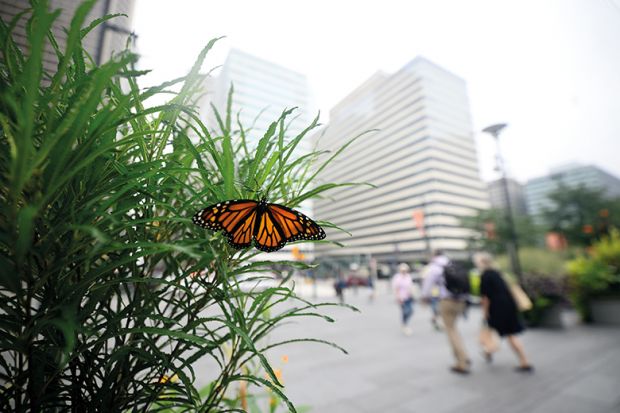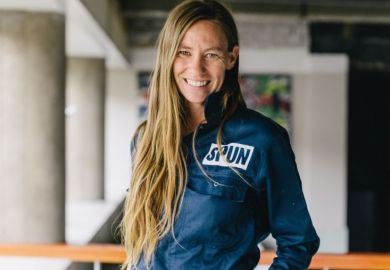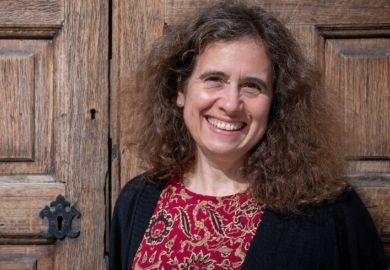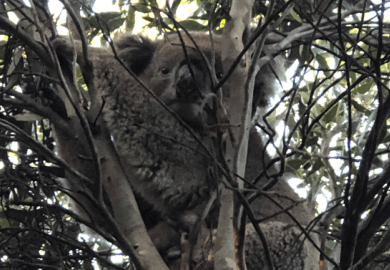It has become clear in recent years that all natural places are in some way shaped by human action, sometimes long past, some for the good, much still for the bad. There is only one system boundary that really matters, that of planet Earth itself. And it faces a number of interlocking crises: biodiversity extinctions, air pollution in cities, soils eroding, plastic in rainfall as well as in seas, and climate change to link them all. We are in a small boat in deep space and those with oars are rowing in different directions. Sea monsters await below. How, then, can we humans cooperate to amend our choices and policies in order that we may redesign away these problems?
Nick Haddad’s fine and compelling book is about six butterflies, yet it is also about so much more. As we all know, profile and urgency are easier to create for the charismatic icons – tiger and panda, whale and elephant – even if the news remains somewhat grim. Yet it is also the small things that matter in ecosystems. They are the canary in the coal mine, litmus paper and signifier. For two years, on the Suffolk-Essex border, we did not see a single honeybee. Now we know that the residues of certain modern insecticides, currently banned, travel through the soil to be expressed in wild flowers. The bees were harmed not from being in fields but from foraging in hedge, woodland and garden. If we want to save a species, as Haddad shows for the Bay Checkerspot and Fender’s Blue, for the Crystal Skipper and St Francis’ Satyr, then we need to protect and enhance whole habitats. Butterflies will neither survive nor thrive unless there is swift and widespread action. Meanwhile, we may find ourselves stitching sorrow into every sinew.
Haddad began his career studying the Mediocre Skipper butterfly, an inch across and flecked dull brown. Its Latin name is Inglorius. This is instructive. We will not be thanked if we save the Monarch and let go the Mediocre. In the northern Guatemalan rainforest, there are 500 species of butterfly; in the UK, we have just 59. In both country contexts, in all ecosystems, every one matters. Worldwide, there are 19,000 butterfly species; some have become very rare, dangerously close to extinction. The entire population of Schaus’ Swallowtail would fit in your hand, weighing about 150g. Some species once were very abundant, but have dropped away and are now living on tiny parcels of this planet, a single golf course or sports field. One change in land use, one shift in climate, one extreme storm or drought, and that’s it.
Many rely on a single plant species to lay eggs and feed caterpillars. If we want butterflies in our garden, allotment or local park, then we have to manage the plants. We see butterflies as adults, Red Admirals and Peacocks brightly flitting in dappled sunlight, whites circling the vegetables, blues in meadows. But their life cycles vary hugely. Some migrate, some hibernate; some adults live for only days; all need very specific host plants. In a dramatic piece of research published in 2017, total insect numbers in Europe were found to have fallen by 75 per cent in the past 35 years – remember the blizzard of moths and night insects when driving in the dark, and compare the clean windscreen today. This is not progress, even if you do not need to clean your car so often.
Haddad focuses mainly on butterflies of the Americas, yet also includes a chapter on Britain’s Large Blue, first named by Linnaeus in 1758. Its caterpillars fed on wild thyme: note the past tense. It is extinct. It was studied for decades, yet we failed. It was native to the south west, and numbers were noticed as falling in the late 19th century, even though there remained thyme in meadows that survived the plough. What turned out to be crucial was the red ant, Myrmica. It was found that caterpillars secreted sugary honeydew, and this was a rich source of food for ants. Ants farmed the caterpillars, carrying them off to their nests. The caterpillars, in return, fed on ant larvae in the period just before pupation.
Recent research has filled out this story of mutualism. Many plants, including crops, emit semiochemicals that both push away pests and pull in insect predators and parasites. This is leading to an understanding in agriculture that systems can be redesigned with a mix of crops and non-crops that do the job of insect control very well, without insecticides. Here it was found that the wild thyme emits volatile compounds that affect both ant and butterfly. They pull them in. The thyme also contains toxins that both ant and butterfly build up in their bodies, providing protection from predators, thus clearing away competitors. The mutualism now includes butterfly, ant and thyme, the sharing of habitat, and the influence of compounds that shape their common niche (or home).
Yet it turns out to be more complex. Only one species of red ant works – not any ant, not other reds. And meadows must be managed in very particular ways, especially with grass height no more than 5cm. Here the rabbit, a Roman import that has become native, comes in. Numbers fell dramatically after myxomatosis arrived in the UK in 1953. Meadows grew longer. Others were grazed by cattle instead of sheep; others still were fertilised to increase productivity. And so conservation failed, and the final flight of the Large Blue was in 1979. Since then we have seen a different kind of success, for a subspecies Blue from Sweden was introduced and has thrived in patches.
What lessons does Haddad want us to draw from these excellent tales? That species loss is for ever, that the abundant species falling in numbers, such as the Monarch, may disappear before our eyes. And that action at the habitat level is going to be critical if we are to maintain the tapestry of biodiversity. And this is never about a large number of unconnected species, once pinned out separately in collections; it is all about the subtle and often critical connections between plant, animal and human.
Haddad concludes by writing that he is nearly always asked, when giving public talks, why should we care about rare butterflies? It is not pollination – their effect is small. Like a sunset or birdsong, they do not contribute to the GDP or the economy. They do not help us to buy more stuff. But we do notice them, as we have in great numbers this summer. Butterflies tell us something, very directly, about whether we are caring enough for this blue-green planet.
Jules Pretty is professor of environment and society at the University of Essex. His latest book is the award-winning The East Country: Almanac Tales of Valley and Shore (2017).
The Last Butterflies: A Scientist’s Quest to Save a Rare and Vanishing Creature
By Nick Haddad
Princeton University Press
264pp, £20.00
ISBN 9780691165004
Published 25 June 2019
The author
Nick Haddad, a professor in the department of integrative biology at Michigan State University, was born in Rochester, Minnesota and mainly grew up in the same state, although summers at his grandparents’ farm in Maryland helped spark his love for nature. While at Stanford University as an undergraduate, he recalls, he “wound through several majors including engineering, economics and genetics” before he “ended up studying ecology”. The course involved research expeditions to California and Colorado to study the diversity of bird life. More significant for the theme of his new book, he was also “dropped into northern Guatemala for two years to study the diversity of tropical butterflies”.
When he went on to graduate school at the University of Georgia, Haddad had a supervisor who allowed him to “go to a field station to create a large experiment to test how to reconnect natural areas for biodiversity” – an experiment he is still running a quarter of a century later. His adviser also steered him away from his initial interest in birds and towards butterflies.
But although butterflies proved useful for “testing hypotheses about habitat loss”, Haddad’s “true passion was conservation of biodiversity” and he had a sense that his “studies were too abstracted from conservation to feel that I was making a real difference”. When he arrived as a professor at the University of North Carolina, therefore, he was delighted to get a chance specifically to study rare butterflies.
So what needs to be done to get the public more interested in their conservation? “Butterflies often live in surprising places (military bases, beachfronts),” Haddad replies, “and this provides a hook to engage people.” He is also a strong believer in “citizen science”, whereby “programmes engage people to make observations of butterflies and other insects. The signature programme is the UK Butterfly Monitoring Scheme.”
Matthew Reisz
POSTSCRIPT:
Print headline: On fragile wings, a warning
Register to continue
Why register?
- Registration is free and only takes a moment
- Once registered, you can read 3 articles a month
- Sign up for our newsletter
Subscribe
Or subscribe for unlimited access to:
- Unlimited access to news, views, insights & reviews
- Digital editions
- Digital access to THE’s university and college rankings analysis
Already registered or a current subscriber? Login








